NREL Water Power Newsletter, The Current, Fall 2024
In this issue, learn about NREL's role at Clean Currents, explore a new video on floating solar pv, catch up on hydropower and marine energy news, and more.
This quarterly newsletter highlights the latest from NREL's Water Power Program.
Subscribe to Newsletter
To receive quarterly updates about NREL water power news, accomplishments, events, and more, subscribe to The Current newsletter.
SUBSCRIBEIn This Issue
NREL at Clean Currents
Photo by Emily Hagen, NREL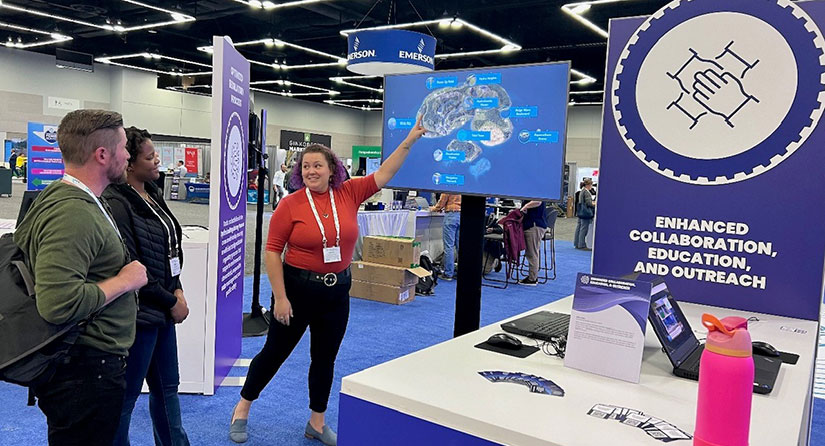
NREL had a strong presence at Clean Currents Oct. 7–10, in Portland, Oregon. Clean Currents is a premier national water power tradeshow and conference that brings together industry professionals from sectors including conventional hydropower, pumped storage hydropower, small hydropower, and marine energy.
This year’s event facilitated collaboration, encouraged innovation, and advanced the industry toward a sustainable and clean energy future. More than 80 members from NREL, the U.S. Department of Energy (DOE), and other national labs were in attendance this year. NREL led multiple sessions and panels and showcased demonstrations at the Water Power Technologies Office booth on the tradeshow floor and at the Innovation Powerhouse.
At the event, NREL premiered a YouTube video highlighting the Hydropower Emulation Platform. The platform emulates hydropower in a controlled, real-world environment, mimicking how hydropower plants pair up with energy storage and other renewable energy technologies to provide more reliable energy to a grid.
What To Watch
Floating Solar PV: Powering the Future From Federally Controlled Reservoirs
Solar energy isn’t limited to land. In this YouTube video, NREL and Idaho National Laboratory explored the potential of siting floating solar panels on federally controlled reservoirs. Learn how this innovative solution has enough technical potential to generate up to half of the solar energy needed to decarbonize the U.S. electric grid by 2050 while reducing water evaporation and protecting aquatic habitats. Discover how floating solar can be sited on non-powered dams or integrated with hydropower to boost energy production and reduce costs.
Cross-Cutting News
ARIES Allows Users To Integrate Water Power Resources Into Grid Simulations
The Advanced Research on Integrated Energy Systems (ARIES) platform uses data from real-world wind turbines, solar panels, hydropower generators, and more to create a highly accurate virtual simulation of different grid scenarios and how they might react to changes in energy demand, weather, and higher levels of renewable energy. New enhancements to the platform are now making it possible for users to integrate hydropower and marine energy assets into these simulations, which could be especially helpful for remote, coastal towns with abundant water supplies. ARIES’ new capabilities will allow communities to make decisions about adopting clean energy resources with greater confidence.
Hydropower News
New NREL Tool Estimates Lifetime Greenhouse Gas Emissions of the Most Well-Established Grid-Scale Energy Storage Technology
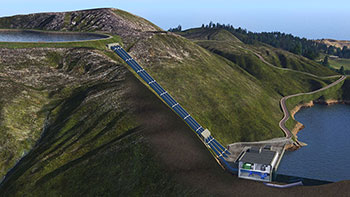
Image from IKM 3D
NREL has developed a first-of-its-kind tool that enables hydropower operators and developers to estimate the greenhouse gas emissions associated with building and operating closed-loop PSH facilities, as seen on this YouTube video. Closed-loop PSH generates and stores electricity by moving water between an upper and a lower reservoir. It is an established technology that accounts for most of today’s grid-scale energy storage. Learn how hydropower developers and operators can use the tool to select sites, components, and specifications that minimize emissions.
Supply Chain Report Tackles Hydropower’s Missing Links
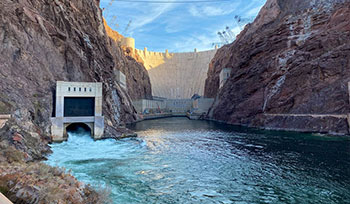
Photo from Connie Castle via the 2023 Make a Splash Photo and Video Contest
A recently released NREL report, Hydropower Supply Chain Gap Analysis, considers sectors of the hydropower supply chain—from mining and extraction to installation and construction. The report identifies five key gaps in the domestic supply chain and provides actionable recommendations for addressing them. The report builds on the DOE Hydropower Supply Chain Deep Dive Assessment, part of a series of reports aimed at building more secure and diverse U.S. supply chains.
Introducing the Cybersecurity Value-at-Risk Framework 2.0
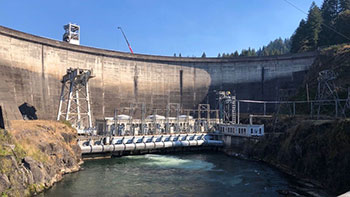
Photo by Anuj Sanghvi, NREL
NREL has released version 2.0 of the Cybersecurity Value-at-Risk Framework (CVF), a free, publicly available tool that offers owners and operators of hydropower facilities a self-guided, automated way to assess their plant’s cybersecurity risks and consider the best upgrade investments. The tool provides risk probabilities and scores, highlighting the financial value of cybersecurity improvements needed to handle future threats. Whereas the original CVF allowed users to assess only one facility per organization, CVF 2.0 allows users to assess multiple facilities in an organization. Read more about these updates to the CVF.
New Tool Can Advance Hydropower Cybersecurity Through Artificial Intelligence
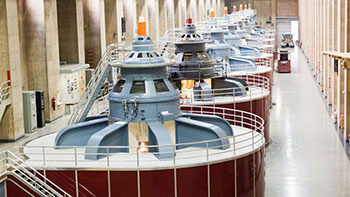
Photo from Getty Images
NREL recently announced the cybersecurity situational awareness tool (CYSAT) for hydropower, a new tool that can advance hydropower plant cybersecurity. Using state-of-the-art artificial intelligence, CYSAT detects stealthy cyberattacks early, minimizes evolving cybersecurity risks, analyzes grid performance through technical and economic metrics, and aids grid operators in making informed decisions to enhance the resiliency and security of hydropower plants.
Marine Energy News
University Partnership Envisions the Next Generation of Flexible Wave Energy

Photo by Greg Cooper, NREL
NREL's wave tank hosted the evaluation of the Origami FlexWEC, a wave energy converter based on distributed embedded energy converter technologies, or DEEC-Tec. The FlexWEC integrates small energy converters, causing the structure to be both flexible and foldable. The flexible structure inherently enables the converter to capture a wider range of ocean wave frequencies, and its foldability enables the converter to be configured for different situations, such as being transported/deployed versus being in ocean wave energy conversion mode. The evaluation was led by NREL's Blake Boren, in collaboration with Ph.D. student Isabel Hess and her advisor, Patrick Musgrave, from the University of Florida. The team also developed a visual diagnostic system to analyze the prototype’s underwater movements, gathering essential data for future improvements. This partnership not only advanced the FlexWEC but also opened doors for broader innovation in marine energy.
Reeling In Marine Energy Data With Expanded Analysis Tools
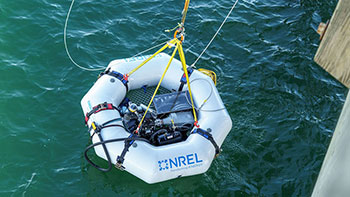
Photo by Andrew Simms, NREL
Marine energy devices have the potential to deliver gigantic amounts of power―if they can survive the ocean's punishing conditions. Innovative system designs are needed to convert wave movements into electricity, but the sea is vast and complex, and deployment in these remote locations is expensive. Created by NREL, Pacific Northwest National Laboratory, and Sandia National Laboratories, the Marine and Hydrokinetic Toolkit (MHKiT) on GitHub can save time and money in the assessment of breakthrough technologies in marine renewable energy and their performance under a wide range of aquatic conditions. Read more about how this software charts a course to catch maximum electricity from waves, tides, and currents.
PRIMRE Releases Telesto Knowledge Hub Video
Have you heard about the Portal and Repository for Information on Marine Renewable Energy’s (PRIMRE’s) knowledge hub Telesto? Telesto offers guidance and helpful resources for planning, building, and deploying marine energy devices. From inception to decommissioning, Telesto hosts open-source wikis and databases for marine energy planning, testing, measurement, and data processing. Learn more about Telesto on YouTube and watch other overview videos on PRIMRE’s knowledge hubs, including Tethys Engineering, Marine Energy Software, and the Marine Energy Projects Database. These videos are all available on the PRIMRE YouTube Playlist from OpenEI.
Updated Marine Energy Risk Management Framework Aims To Improve the Development and Successful Deployment of Marine Energy Technology
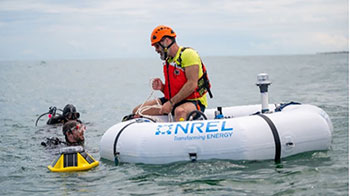
Photo from John McCord, Coastal Studies Institute
An updated technical report from NREL showcases the Marine Energy Risk Management Framework, a document that aims to help developers identify, manage, and respond to risks throughout the development cycle. By addressing these risks, NREL hopes this framework will support the advancement of new technologies and increase the chances of successfully developing marine energy converter technology. Originally developed in 2015, this framework covers projects of any technology readiness level or technology performance level and all risk types. It will be used on any DOE Water Power Technologies Office projects that require system testing in the open water.
Prizes and Competitions
Potential Prize To Transform How Renewables and Storage Resources Are Integrated Into the Grid
As the electricity sector moves toward a zero-carbon future, current market structures may not fully support this transition. To develop innovative market designs for a future power grid, NREL and DOE are exploring a potential prize competition to redefine how electricity markets support renewables and storage resources and create innovative solutions for the challenges ahead. NREL has issued a request for information to gather feedback and gauge interest in this proposed opportunity. Interested prize competitors and reviewers are encouraged to share feedback via the request for information by Dec. 2 to inform the prize administration team’s decision-making process.
Beneath the Surface: Anuj Sanghvi’s Journey From Toy Tinkerer to Cybersecurity Defender
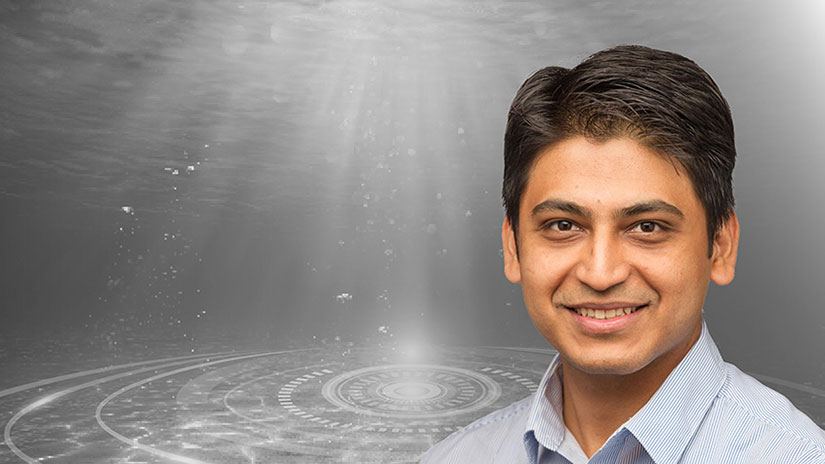
Anuj Sanghvi had to train himself for a career in research.
Sanghvi, now an NREL cybersecurity researcher and network security engineer, always knew he wanted to work in engineering. He was one of those children—the ones who take toys and electronics apart to play with the circuit boards.
“It fascinated me how great minds thought these things up and put them together,” Sanghvi recalled. “I had to figure out how they did it and how these things worked.”
Read the full story of how Sanghvi’s childhood urge to dismantle his toys led to a career in defending clean energy data from cyberattacks.
Events and Opportunities
Visit the NREL Water Research Events page for more event information and registration details on upcoming workshops and events.
Upcoming Events
Floating PV Technical Resource Assessment and Regulatory Pathways
Dec. 5, 2024, 12–1 p.m. MT, Virtual
As part of an AquaPV webinar series, this Idaho National Laboratory and NREL webinar on Microsoft Teams will explore the technical resource potential at federally controlled reservoirs and the associated regulatory pathways for obtaining floating PV project approval from federal agencies.
American Geophysical Union 2024
Dec. 9–13, 2024, Washington, D.C.
Each year, more than 25,000 attendees from more than 100 countries gather for the American Geophysical Union’s (AGU’s) annual meeting to share research and connect with colleagues. Scientists, educators, policymakers, journalists, and communicators will attend AGU24 to better understand our planet and environment, creating pathways to discovery, generating greater awareness to address climate change, encouraging greater collaborations to lead to solutions, and opening up the fields and professions of science to a whole new age of justice equity, diversity, inclusion and belonging. This December, AGU24 returns to Washington, D.C., with the theme “What’s Next for Science.”
Opportunities
Request for Information: Testing Expertise and Access for Marine Energy Research
NREL has issued a request for information on behalf of the Testing Expertise and Access for Marine Energy Research (or TEAMER™) program, sponsored by DOE’s Water Power Technologies Office and directed by the Pacific Ocean Energy Trust. Provide your anonymous feedback to inform the selection of appropriate facilities that can effectively fill in commercialization and sustainability gaps for marine energy developers and researchers.
NREL in the News
Highlights on new DOE funding for hydropower and marine energy technologies:
DOE Funding To Advance Hydro and Marine Energy Technologies, International Water Power and Dam Construction
U.S. DOE Pours $33M Into Marine and Hydropower Projects To Boost Innovation and Commercialization, Offshore Energy
DOE Doles Out Another $33M for Hydropower Projects, R&D, Hydro Review
Showcasing NREL’s PSH life cycle assessment:
Tool Estimates GHG Emissions for Pumped Storage Hydropower, International Water Power and Dam Construction
NREL Develops Tool To Estimate Emissions From Closed-Loop Pumped Storage, Hydro Review
Life Cycle Assessment of New Closed-Loop Pumped Storage Hydropower Facilities — NREL, Cyote Gulch
Showcasing NREL’s PSH life cycle assessment and how the assessment informs a DOE energy
storage project:
U.S. Department of Energy Finalizes $81 Million Award for Lewis Ridge Long-Duration Energy Storage Project, Yahoo! Finance
DOE Finalizes $81M Award for Lewis Ridge Pumped Storage Project, Hydro Review
MHKiT:
How DOE Aims To Harness Marine Renewable Energy, Thomas Net
Updates to NREL’s CVF:
New NREL Framework Helps Hydro Plant Owners Assess Cybersecurity Risks, Power Engineering
New NREL Framework Helps Hydro Plant Owners Assess Cybersecurity Risks, Hydro Review
NREL’s Hydropower Supply Chain Gap Analysis:
NREL: Supply Chain Report Tackles Hydropower’s Missing Links, Maven's Notebook
NREL’s CYSAT for hydropower:
New AI Tool To Advance Hydropower Plant Cybersecurity, Power Engineering International
New Tool To Advance Hydropower Plant Cybersecurity Through AI, Hydro Review
New AI Tool Aims To Strengthen Cybersecurity at Hydropower Plants, International Water Power and Dam Construction
How the ARIES platform is integrating water power:
How a Clean Energy Simulator Is Helping Build a Better Grid, AltEnergyMag
NREL’s Large-Scale Research Platform Updated To Include Hydro, Marine Energy, Hydro Review
How a Clean Energy Simulator Is Helping Build a Better Grid, Tech Xplore
Marine Technology News explores how NREL research supports a wave energy converter project from the University of Michigan.
Clean Technica explores how NREL research on tidal energy relates to an underwater kite-style tidal device.
Clean Technica uses NREL data to explore wave energy potential.
Publications
See all the latest publications, or explore these featured publications.
Hydropower
How Fisheries Biologists Can Facilitate the Clean Energy Transition, Fisheries (2024)
Hydropower Supply Chain Gap Analysis, EERE Technical Report (2024)
Marine Energy
Polymer Additive Manufacturing for Marine Renewable Energy Applications: Best Practices, Research Trends, and Current Challenges, NREL Technical Report (2024)
Marine Energy Technology Development Risk Management Framework, NREL Technical Report (2024)
Submerged Fatigue Testing of Marine Energy Advanced Materials, SAMPE Journal (2024)
Data Acquisition and Control for Marine Energy Devices: Cost Considerations, NREL Technical Report (2024)
Additive Manufacturing for Powering the Blue Economy Applications: A Tidal Turbine Blade Case Study, European Wave and Tidal Energy Conference (2023)
Want More?
Subscribe to The Current to get the next water power newsletter in your inbox.
Subscribe to The SPLASH to get the next STEM newsletter in your inbox.
For the latest from the DOE Water Power Technologies Office, sign up for its water power newsletters. Have a more general question or can’t find what you’re looking for? Send us an email at water.power@nrel.gov.
Share

